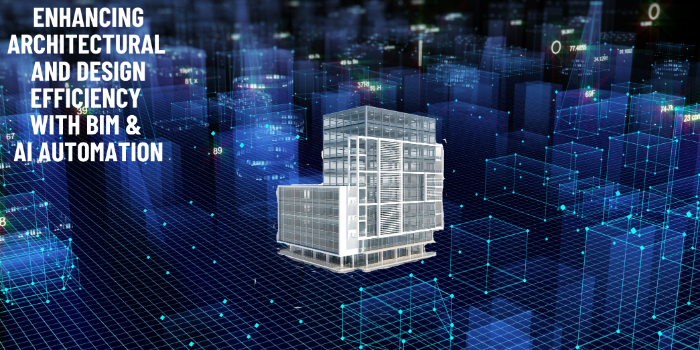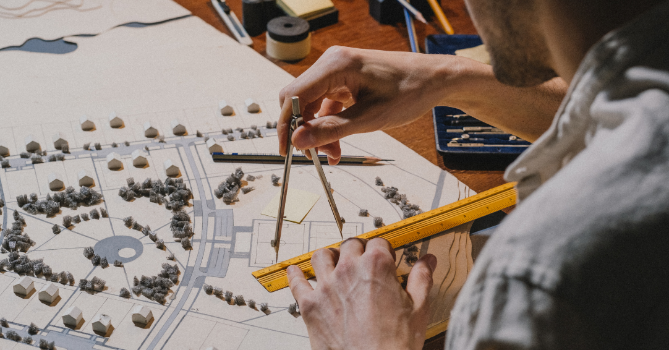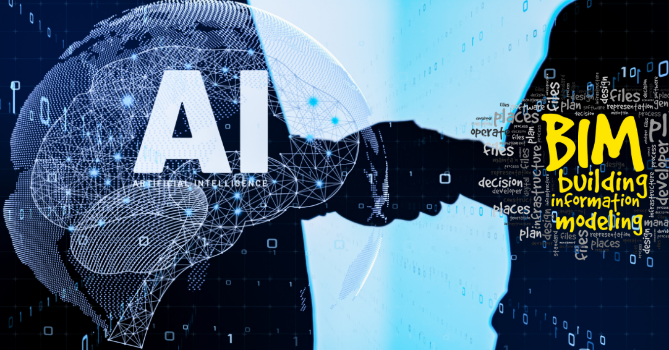
Enhancing Architectural and Design Efficiency with BIM & AI Automation
Introduction
In today’s fast-paced world, architects and designers face growing pressure to complete projects faster and more efficiently. Deadlines are tighter, and the need for precision has never been greater. This is where Building Information Modeling (BIM) and Artificial Intelligence (AI) come into play.

BIM is a powerful tool that creates digital representations of buildings, allowing for more accurate planning and design. When combined with AI, it transforms the way projects are managed. AI can process vast amounts of data quickly, offering insights and solutions that humans might miss. Together, BIM and AI streamline the design process, helping architects and designers work smarter, not harder.
These technologies are not just about saving time; they also improve accuracy, reduce errors, and optimize resources. As the industry continues to evolve, the integration of BIM and AI will only grow, making them essential tools for any forward-thinking architecture and design firm.
Understanding BIM & AI: The Power Duo
Building Information Modeling (BIM) is a digital tool that creates detailed 3D models of buildings. These models include everything from floor plans to electrical systems. BIM helps architects and designers visualize and plan projects with greater accuracy. It allows for better collaboration among teams, ensuring everyone is on the same page.

Artificial Intelligence (AI), on the other hand, is about machines learning from data. AI can analyze vast amounts of information quickly, making it possible to identify patterns and predict outcomes. When AI is combined with BIM, the results are impressive. AI can process BIM data and suggest design improvements, detect potential problems, and even automate repetitive tasks like clash detection.
For example, AI can scan a BIM model and identify areas where different building systems might conflict, like where a pipe might run into a beam. It can also predict how changes in one part of a design will impact the rest of the project. This level of insight helps architects and designers make smarter decisions faster.
The combination of BIM and AI doesn’t just save time; it also increases the accuracy and efficiency of the design process. As these technologies continue to evolve, their role in architecture and design will only become more significant.
Key Benefits of BIM & AI Automation in Architecture
Integrating BIM with AI brings several key benefits to the architecture world. One of the most significant is improved accuracy. BIM models provide detailed, precise representations of a building, and when AI is applied, it can analyze these models to catch errors early. For instance, AI can identify potential design flaws before construction begins, reducing costly mistakes and rework.

Another major benefit is faster project delivery. AI automation speeds up many time-consuming tasks. For example, generating cost estimates, scheduling, and detecting clashes between building systems are all tasks that AI can handle quickly. This allows architects and designers to focus on more creative aspects of the project while ensuring that everything runs smoothly in the background.
Enhanced collaboration is also a notable advantage. BIM allows different teams to work together on the same model, and AI enhances this by providing real-time insights and suggestions. Teams can make informed decisions faster, which improves communication and reduces misunderstandings. This leads to a more cohesive workflow where everyone is aligned on the project’s goals.
Cost savings are another critical benefit. By reducing errors, speeding up tasks, and improving collaboration, BIM and AI help lower overall project costs. Resources are used more efficiently, and projects are more likely to stay on budget.
Finally, BIM and AI promote sustainability. AI can analyze a BIM model to suggest energy-efficient designs or materials, helping architects create greener buildings. As the demand for sustainable construction grows, this capability becomes increasingly valuable.
Overall, the combination of BIM and AI not only enhances efficiency but also brings significant value to architectural projects, making them more accurate, faster, and cost-effective.
Overcoming Challenges and Maximizing Efficiency
While the benefits of BIM and AI are clear, implementing these technologies can come with challenges. One of the biggest hurdles is the initial cost. Both BIM and AI require investments in software, hardware, and training. For some firms, especially smaller ones, this can be a significant barrier. However, it’s important to view this as a long-term investment. The efficiency gains and cost savings over time often outweigh the upfront expenses.

Another challenge is the learning curve. BIM and AI are complex tools, and it takes time for teams to become proficient. To overcome this, firms should invest in comprehensive training and support. Partnering with technology providers or hiring specialists can also help bridge the knowledge gap, ensuring that the transition is as smooth as possible.
Resistance to change is another common issue. Some team members may be hesitant to adopt new technologies, especially if they’re used to traditional methods. To address this, it’s crucial to involve the entire team in the process. Communicating the benefits and providing ongoing support can help ease the transition.
Maximizing efficiency with BIM and AI requires careful planning. Start with smaller projects to build confidence and gradually scale up as the team becomes more comfortable. It’s also essential to choose the right tools for your specific needs. Not all BIM and AI solutions are the same, so it’s important to select those that align with your firm’s goals and project requirements.
By addressing these challenges head-on and taking a strategic approach, firms can unlock the full potential of BIM and AI, leading to greater efficiency, improved project outcomes, and long-term success.
The Future of BIM & AI in Architecture and Design
The future of architecture and design is set to be deeply influenced by the continued integration of BIM and AI. As these technologies evolve, they will become even more essential in shaping how projects are conceived, planned, and executed.

One exciting development is the rise of Digital Twins. These are real-time digital replicas of physical buildings that use BIM and AI to monitor and manage structures throughout their lifecycle. This technology will allow architects and designers to predict maintenance needs, optimize energy use, and improve overall building performance.
AI is also expected to become more autonomous in design tasks. We may soon see AI tools that can generate entire building designs based on specific criteria, reducing the time needed for initial planning stages. This would free up architects to focus on more complex and creative aspects of their work.
As sustainability continues to be a priority, BIM and AI will play a key role in designing greener buildings. AI can analyze data from past projects to suggest eco-friendly materials and energy-efficient designs, helping meet growing environmental standards.
Overall, the future of BIM and AI in architecture promises to be innovative, efficient, and sustainable, transforming the industry in ways we are only beginning to imagine.
Conclusion
BIM and AI are revolutionizing the architecture and design industry by enhancing efficiency, accuracy, and collaboration. These technologies help teams deliver projects faster, reduce errors, and lower costs. While there are challenges, such as the initial investment and learning curve, the long-term benefits make them worthwhile. As we look to the future, the role of BIM and AI will only grow, with innovations like Digital Twins and autonomous design tools leading the way. Embracing these technologies now will position firms for success in an increasingly competitive and sustainability-focused industry. It’s time to harness the power of BIM and AI to build a smarter, more efficient future in architecture and design.